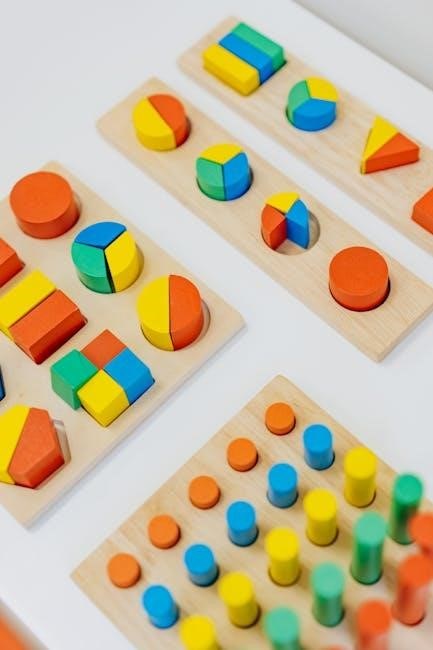Kindergarten math tests are essential for assessing foundational skills and cognitive development in young learners. These tests evaluate critical thinking, problem-solving abilities, and understanding of basic concepts. Resources like “Kindergarten Math with Confidence” provide structured support for educators and parents, ensuring comprehensive assessment and learning opportunities for children.
Importance of Kindergarten Math Tests
Kindergarten math tests identify early learning gaps, ensuring timely intervention. They measure foundational skills and readiness for future math concepts, guiding targeted support and instruction for young learners.
Foundational Skills
Kindergarten math tests focus on assessing foundational skills, such as number sense, counting, and basic operations. These skills are crucial for building a strong mathematical understanding. Tests often include identifying numbers, sequencing, and simple addition or subtraction. For instance, “Kindergarten Math with Confidence” provides structured workbooks that help children master these concepts through engaging activities. These foundational skills are essential for problem-solving and critical thinking, enabling children to tackle more complex math problems in later grades. By evaluating these skills early, educators can identify areas where students may need additional support, ensuring a solid mathematical foundation. These tests also introduce children to the concept of mathematical reasoning, preparing them for advanced topics like shapes, patterns, and measurement. Thus, foundational skills assessed in kindergarten math tests play a pivotal role in shaping a child’s mathematical journey. They are the building blocks for future academic success.
Cognitive Development
Kindergarten math tests play a vital role in fostering cognitive development by enhancing critical thinking and problem-solving skills. These tests introduce children to logical reasoning, helping them understand cause-and-effect relationships and spatial awareness. For example, identifying shapes and patterns encourages visual-spatial skills, while counting games improve memory and concentration. Structured programs like “Kindergarten Math with Confidence” incorporate engaging activities that stimulate mental growth. By solving math problems, children develop their ability to analyze information, make decisions, and think creatively. These skills are not only essential for academic success but also for everyday problem-solving. Cognitive development is further supported by resources that ensure accessibility, such as Ontario government initiatives, which aim to make math education inclusive for all learners. Ultimately, kindergarten math tests serve as a tool to nurture young minds, preparing them for more complex challenges in education and beyond. This early exposure to math concepts lays the groundwork for lifelong learning and intellectual growth.
Structure of a Typical Kindergarten Math Test
A typical kindergarten math test includes sections on number recognition, basic operations, shapes, and patterns. Tests often feature interactive elements, visual aids, and hands-on activities to engage young learners and assess their understanding of foundational concepts effectively.

Content and Format
A typical kindergarten math test includes a variety of engaging and age-appropriate activities designed to assess foundational skills. The content often focuses on number recognition, counting, shapes, patterns, and basic operations like addition and subtraction. Questions are presented in a visual and interactive format, using images, objects, and simple language to ensure clarity for young learners.
The format typically involves multiple sections, each targeting specific skills. For example, one section might ask students to identify and match shapes, while another might involve counting objects and writing the corresponding numbers. Tests may also include coloring activities or puzzles to make the experience enjoyable and less intimidating.
Visual aids, such as number lines, counting blocks, and pattern templates, are frequently incorporated to support understanding. The test is designed to cater to different learning styles, ensuring that all students can participate and demonstrate their knowledge effectively. This structure helps educators and parents assess a child’s readiness for further math concepts while keeping the process fun and engaging.
Additionally, the format often includes clear instructions and examples to guide students through the test. This ensures that young learners can focus on the math skills being assessed rather than struggling with complex instructions. Overall, the content and format of kindergarten math tests are carefully crafted to be both educational and accessible for young children.
Key Skills Assessed
Kindergarten math tests evaluate essential skills like number sense, shape recognition, pattern awareness, and basic operations. These assessments help identify a child’s understanding of foundational concepts, ensuring readiness for more complex math in future grades.
Number and Operations
Kindergarten math tests emphasize number sense and basic operations, fostering foundational math skills. These assessments evaluate a child’s ability to count, recognize numbers, and understand simple arithmetic like addition and subtraction. Problem-solving strategies, such as using fingers or objects to solve problems, are also assessed to gauge cognitive development. The tests often include exercises that involve sequencing numbers, identifying missing numbers in a sequence, and basic concepts of “more” or “less.” These skills are crucial for building a strong math foundation, as they form the basis for more complex operations in higher grades. By incorporating visual aids and hands-on activities, kindergarten math tests ensure that young learners engage with numbers in a way that is both fun and educational, preparing them for future academic success.
Shapes and Patterns
Recognizing shapes and creating patterns are fundamental skills assessed in kindergarten math tests. These exercises help children develop spatial awareness, logical reasoning, and problem-solving abilities. Tests often include identifying basic shapes like squares, circles, and triangles, as well as understanding shape properties. Patterns are introduced to encourage critical thinking, with questions asking students to complete or create sequences using objects or shapes. Visual aids, such as blocks or colored tiles, are frequently used to make these concepts engaging and accessible. Assessments may also involve matching games or arranging items in a specific order, fostering organizational skills. These activities not only enhance math comprehension but also prepare children for more complex geometry and algebraic concepts in later years. By mastering shapes and patterns, young learners build a solid foundation for understanding mathematical relationships and structures.

Preparing for the Test
Educators and parents play a crucial role in preparing children for kindergarten math tests. Utilizing practice tests and visual aids helps build confidence and familiarity with test formats, ensuring young learners are well-prepared.
For Teachers
Teachers play a vital role in preparing students for kindergarten math tests. They can use structured resources like “Kindergarten Math with Confidence” to create engaging lesson plans. Incorporating hands-on activities and visual aids helps reinforce foundational math concepts. Regular practice tests allow teachers to identify areas where students may need additional support. Providing clear instructions and encouraging critical thinking fosters a positive learning environment. Teachers should also focus on building students’ confidence by celebrating progress and offering constructive feedback. Utilizing digital tools and educational apps can further enhance math skills in a fun and interactive way. By aligning teaching strategies with curriculum standards, educators ensure comprehensive preparation for math assessments. Continuous assessment and adaptation of teaching methods are key to meeting individual student needs. Overall, teachers are instrumental in laying a strong mathematical foundation for young learners.
For Parents
Parents can significantly contribute to their child’s success in kindergarten math tests by providing consistent support and practice at home. Using resources like “Kindergarten Math with Confidence” can help parents understand the curriculum and reinforce learning. Encouraging daily math practice through fun activities, such as counting games or shape recognition, can build foundational skills. Parents should also communicate with teachers to stay informed about their child’s progress and identify areas needing extra attention. Creating a positive learning environment at home fosters a love for math and reduces test anxiety. Utilizing free online assessments, like those from K5 Learning, allows parents to track their child’s growth and address gaps in understanding. Celebrating small achievements and offering constructive feedback helps build confidence and a growth mindset. By staying involved and proactive, parents can play a crucial role in preparing their child for math tests and fostering long-term academic success.

Designing Effective Test Questions
Effective test questions should be clear, engaging, and visually supported. Using images, charts, and interactive elements helps young learners understand concepts. Questions should allow students to demonstrate problem-solving skills and creativity, fostering a deeper understanding of math concepts.
Effective Question Types
Effective question types in kindergarten math tests should be engaging and tailored to young learners’ cognitive levels. Open-ended questions encourage critical thinking and allow children to explain their reasoning. Multiple-choice questions with visual aids, such as images or objects, help simplify complex concepts. Interactive questions, like drawing or counting activities, make assessments feel like play while assessing understanding. Incorporating problem-solving scenarios with familiar objects or scenarios enhances engagement. Questions should also promote creativity, such as asking children to create patterns or shapes. Additionally, questions that encourage retrials allow students to learn from mistakes, fostering resilience and a growth mindset. Visual aids, such as charts or number lines, can support comprehension and help children visualize math problems. By using diverse question types, tests can effectively assess a range of skills, from basic number recognition to problem-solving abilities, ensuring a comprehensive understanding of math concepts.

Use of Visual Aids

Visual aids play a crucial role in kindergarten math tests, making complex concepts accessible and engaging for young learners. Tools like number lines, charts, and images help children visualize math problems, enhancing their understanding. Interactive visual aids, such as digital manipulatives or physical objects, allow students to explore concepts hands-on, fostering deeper comprehension. Visual representations of patterns, shapes, and sequences can simplify abstract ideas, making them more tangible for kindergartners. Additionally, visual aids like counters or blocks provide a concrete way to practice counting, sorting, and basic operations. These resources not only support learning but also help assess a child’s grasp of math fundamentals. By incorporating visual aids, tests become more inclusive, catering to different learning styles and ensuring that all students can engage effectively with the material. This approach aligns with modern educational strategies, emphasizing the importance of visual and interactive learning in early childhood education.

Evaluating Test Results
Evaluating kindergarten math test results involves analyzing performance to identify strengths and areas needing improvement. Assessments help track progress, ensuring children are ready for future math challenges and providing insights for tailored teaching strategies.
Analyzing Performance
Analyzing performance in kindergarten math tests involves identifying strengths and areas where children may need additional support. Teachers and parents can use test results to track progress and understand individual learning needs. By reviewing test data, educators can pinpoint specific skills, such as number recognition or shape identification, where students excel or struggle. This process helps tailor instruction to address gaps and reinforce concepts. Assessment tools like “Kindergarten Math with Confidence” and K5 Learning resources provide structured frameworks for analyzing performance. These tools often include progress tracking and detailed reports, enabling a deeper understanding of a child’s mathematical development. By focusing on individual growth, educators can create targeted strategies to help children build a strong foundation in math. Regular analysis ensures that learning is adaptive and responsive to each child’s unique needs, fostering confidence and readiness for future academic challenges.

Additional Resources
For educators and parents preparing children for kindergarten math tests, numerous resources are available to support learning and assessment. Programs like “Kindergarten Math with Confidence” offer comprehensive workbooks and instructor guides tailored for young learners. Online platforms such as K5 Learning provide free math assessments and practice materials, ensuring children are well-prepared. Additionally, websites like Khan Academy and educational forums offer tips for designing effective test questions and strategies to help students improve their problem-solving skills. These resources often include visual aids, interactive activities, and progress tracking tools to make learning engaging and accessible. Parents and teachers can also explore support guides for developing artifacts and commentaries to enhance teaching methods. By leveraging these resources, educators can create a robust learning environment that fosters mathematical confidence and readiness in kindergarten students.



